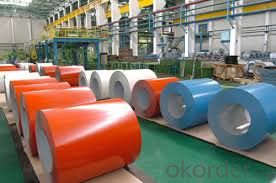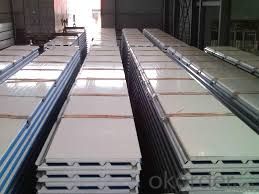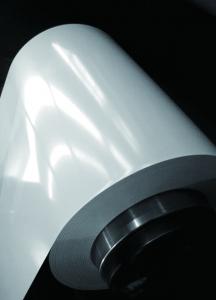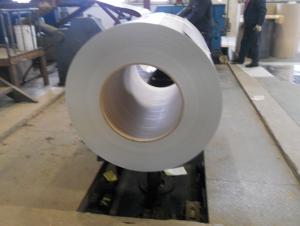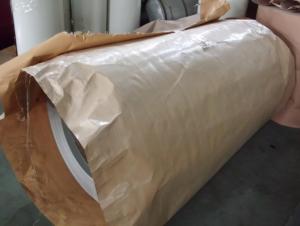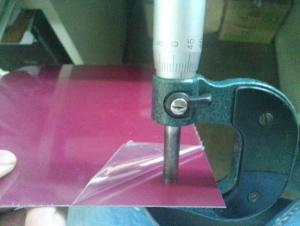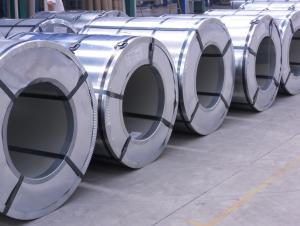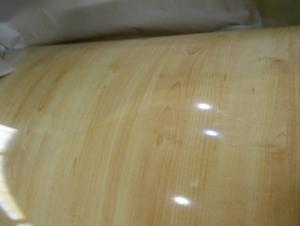Pre-Painted Color Coated Galvanized Steel Coils JIS G3312-2012
- Loading Port:
- Shanghai
- Payment Terms:
- TT OR LC
- Min Order Qty:
- 25 m.t.
- Supply Capability:
- 9000 m.t./month
OKorder Service Pledge
OKorder Financial Service
You Might Also Like
Product Description
Color Coated Galvanized Steel Coil
ISO System
SGS and BV Audited company
Industry experience over 10 years
Management Systems-Internal Software
Finished Product Inventory-More Than 500 Tons
Raw Material inventory -Over 800 Mertic Tons
Shipment of goods -More than 30 countries worldwide
We have the most convenient transport and prompt delivery
We offer competitive price with best service
We have high technical production line with top quality products
We have win high reputation based on best quality products
Product Description
PPGI:
1, Introduction: Color coated steel coils(sheets), i. e. PPGI, also called prepainted steel coils(sheets), are made of galvanized steel coils(sheets) with polymer coatings as surface. It's a new enclosure material and building board with characteristics of light-weighted, heat preserved&insulated, easily installed with bright colors.
2, Production Process: Pretreatment(Degreasing)_Drying_Chromating_Paint Basic Oil_Cooling_Drying_Color Coating_Cooling_Film-covering_Rolling Up
3, Characteristics:
Good at corrosion resistence. Besides zinc coating of the basic plate of galvanized steel sheet, the color coating as the surface has double lifetime to ensure better anticorrosion effect.
with excellent cold bending molded manufacturablity, PPGI products can be processed or directly used as final product. As being light-weighted and conveniently transported, they're widly used to replace wood to save energy.
There're thousands of colors can be chosen as per different application. Any color plays well in decoration.
No pollution with high recycling rate, PPGI coils and sheets are strongly recommended as enviroment-friendly products by the government.
4, Appliance: Thanks to the above characteristics, color coated steel coils and sheets are widly used in construction, furniture industry, transportation industry, ect.
5, eye bands and 4 circumferential bands in steel, galvanized metal fluted rings on inner and outer edges, galvanized.
Type of substrate | Grade of color plate | Standard | Application& feature |
Hot dip galvanized | TDC51D+Z | DC51D+Z | ordinary use |
TDC52D+Z | DC52D+Z | SPCD | |
TDC53D+Z | DC53D+Z | SPCE | |
TS280GD+Z | TS280GD+Z | Structure use | |
TS350GD+Z | TS350GD+Z | Structure use | |
TS550GD+Z | TS550GD+Z | High strength structure use | |
Hot dip galvalume | TDC51D+AZ | DC51D+AZ | ordinary use |
TDC52D+AZ | DC52D+AZ | SPCD | |
TS250GD+AZ | S250GD+AZ | Structure use | |
TS300GD+AZ | 300GD+AZ | Structure use | |
TS350GD+AZ | 350GD+AZ | Structure use | |
TS550GD+AZ | 550GD+AZ | High strength structure use |
Type of coating process | Front:double coated&double drying |
Type of substrate | Hot dip galvanized,galvalume,zinc alloy,cold rolled steel,aluminium |
Coating | Top paint:10-25 micron(Normal 10-12 micron) |
Back paint:5-12 micron(Normal 5-7 micron) | |
ID(mm) | 508/610mm |
Coil weight(ton) | 3-9 ton |
Coating types | Top paint:PVDF,HDP,SMP,PE,PU |
Functions: | Decorative,Machinability,Weather resistance,Scrath resistance,Stain |
Primer paint: | polyurethane,Epoxy,PE |
Back paint: | Epoxy,modified polyester |
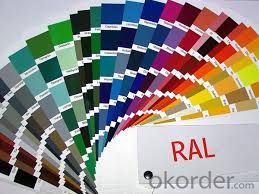
- Q: What are the dimensions of steel coils used in the appliance industry?
- The dimensions of steel coils used in the appliance industry can vary depending on the specific application and requirements. However, the most common dimensions for steel coils used in the appliance industry are typically around 0.015 to 0.035 inches (0.38 to 0.89 millimeters) in thickness, 24 to 36 inches (61 to 91 centimeters) in width, and weighing between 1,500 to 10,000 pounds (680 to 4,535 kilograms). These dimensions allow for efficient handling, transportation, and processing of the steel coils in the appliance manufacturing process. It is important to note that these dimensions can vary and should be confirmed with the specific manufacturer or supplier for accurate and up-to-date information.
- Q: I want to get a new knife but i cant decide if i wan a spyderco pacific salt or a cold steel ak47
- Hibben are even better in my opinion, but cold steel are reputable and do good quality high carbon steel knives and swords. Paul Chen does some knives and they are the best I've seen but a lot more expensive
- Q: What are the different types of steel coil slitting lines?
- There are several different types of steel coil slitting lines that are used in the metal processing industry. These lines are designed to cut large coils of steel into narrower strips, which can then be used for various applications. 1. Loop Slitting Lines: Loop slitting lines are the most common type of slitting line used in the industry. They consist of a decoiler, which holds the coil, a slitter head that cuts the coil into strips, and a recoiler, which winds the strips back into smaller coils. Loop slitting lines are versatile and can handle a wide range of coil widths and thicknesses. 2. Scrap Chopper Slitting Lines: Scrap chopper slitting lines are similar to loop slitting lines but include a scrap chopper unit. This unit cuts any excess material from the edges of the coil before it is slit into strips. This helps to improve the efficiency of the slitting process and reduces waste. 3. Double Loop Slitting Lines: Double loop slitting lines are used for high-speed slitting of thin-gauge coils. They feature two looping pits, which allow for continuous operation. While one coil is being processed, the other is being prepared for slitting, ensuring minimal downtime. 4. Turret Head Slitting Lines: Turret head slitting lines are designed for high-volume production and can process multiple coils simultaneously. They feature a turret head with multiple slitter knives, which can be quickly rotated to switch between different coil widths. This allows for faster and more efficient production. 5. Rotary Shear Slitting Lines: Rotary shear slitting lines are used for thicker and harder materials. They use a rotary shear instead of a slitter head to cut the coil into strips. The rotary shear offers better cutting performance and can handle higher tensile strength materials. 6. Combination Slitting Lines: Combination slitting lines are versatile machines that can handle a range of materials and can perform both slitting and cut-to-length operations. These lines are ideal for smaller manufacturers or those who require flexibility in their production process. Overall, the type of steel coil slitting line used will depend on the specific requirements of the manufacturer, including the type of material being processed, the desired strip width, and the volume of production.
- Q: How are steel coils used in the production of agricultural equipment?
- Steel coils are used in the production of agricultural equipment as they are often shaped and formed into various components such as frames, chassis, and structural parts. These coils provide strength, durability, and stability to the equipment, making it capable of withstanding the demanding conditions and heavy workloads typically associated with agricultural tasks.
- Q: How do steel coils affect the quality of finished products?
- Steel coils can greatly impact the quality of finished products in various industries. One of the key ways steel coils affect product quality is through their dimensional accuracy and consistency. When the steel coils are not properly manufactured or have irregular dimensions, it can lead to issues in the production process and result in finished products that do not meet the desired specifications. Furthermore, the surface quality of steel coils is critical in determining the final appearance and performance of the finished products. Coils with surface defects, such as scratches, rust, or unevenness, can negatively impact the aesthetic appeal of the products, making them less desirable to customers. Moreover, these defects can also affect the functionality and durability of the finished products, leading to potential failures or reduced lifespan. The mechanical properties of steel coils also play a vital role in determining the quality of finished products. Coils with inconsistent or inadequate mechanical properties can compromise the strength, toughness, and overall performance of the end products. For example, in industries such as automotive or construction, where strength and reliability are crucial, the use of steel coils with the wrong mechanical properties can lead to safety hazards or structural failures. Additionally, the chemical composition of steel coils can significantly influence the quality of finished products. The presence of impurities or variations in the alloying elements can affect the material's corrosion resistance, weldability, and other essential properties. This, in turn, can impact the longevity and functionality of the final products. In summary, steel coils have a substantial impact on the quality of finished products. Their dimensional accuracy, surface quality, mechanical properties, and chemical composition all contribute to the overall performance, appearance, and durability of the end products. Therefore, it is crucial to ensure that steel coils used in manufacturing processes meet the desired standards to achieve high-quality finished products.
- Q: How do steel coils differ in terms of size and weight?
- Steel coils can vary greatly in terms of size and weight depending on their intended use and production process. The size of a steel coil is typically measured in terms of its outer diameter, inner diameter, and width. The outer diameter refers to the total diameter of the coil, while the inner diameter refers to the diameter of the hollow center of the coil. The width of the coil refers to the distance between the two flat sides of the coil. In terms of weight, steel coils can range from a few hundred pounds to several tons. The weight of a coil is primarily determined by its size and the type of steel used. Coils made from high-strength steel tend to be heavier due to their higher density, while coils made from lower-grade steel can be lighter. The size and weight of steel coils are crucial factors in determining their transportability and handling. Smaller and lighter coils are generally easier to handle and transport, making them more suitable for applications where maneuverability is important. On the other hand, larger and heavier coils are often used in industries where strength and durability are essential, such as construction and automotive manufacturing. Overall, steel coils can vary significantly in terms of size and weight, allowing for a wide range of applications and customization to meet specific requirements in various industries.
- Q: I need to construct a table with three columns, which states the name of the steel, its compositions (e.g. Fe and C), and its special properties for a variety of different steel products.Help me please, a site with info would be great, explanations would be even better.
- Steel is an alloy consisting mostly of iron, with a carbon content between 0.2% and 2.1% by weight, depending on the grade. Carbon is the most common alloying material for iron, but various other alloying elements are used, such as manganese, chromium, vanadium, and tungsten.[1] Carbon and other elements act as a hardening agent, preventing dislocations in the iron atom crystal lattice from sliding past one another. Varying the amount of alloying elements and form of their presence in the steel (solute elements, precipitated phase) controls qualities such as the hardness, ductility, and tensile strength of the resulting steel. Steel with increased carbon content can be made harder and stronger than iron, but is also less ductile. H.
- Q: I am building a steel type competative team. my team so far isempolem, skarmory , Metagross, magnezone, lucario, ferrothorn.
- Good choice in pokemon. As for moves and EVs and all that... its kinda up to how exactly you wanna play your steel team, but heres what I can think up off the top of my head: Empoleon: Mixed Attacker. Swords Dance and Aqua Jet for strong priority attacking, with two special attacks (preferrably one water and one other non steel non water attack) Skarmory: Physical wall. Skarmory is know to be an amazing physical wall. So pump HP and defense EVs into it. Impish nature is best, and try to get Roost, Whirlwind, and Brave Bird on it. Stealth Rock or Spikes for entry hazard damage. Metagross: Physical attacker. Bullet Punch is nice since Metagross is kinda slow, and Hammer Arm is decent since it hardly cares about a speed drop. Earthquake and Zen Headbutt aren't bad either. Magnezone: Bulky Special Attacker. The teams a really physical one, so having a special attacker is nice so other physical walls don't mess you up too bad. Its main attacking moves should be Thunderbolt and Flash Cannon. Sturdy and Magnet Pull are both good abilities, which one you go with is up to you. Lucario: Physical Sweeper. Max out Lucario's Attack and Speed EVs, its defenses are too low for it to take repeated hits. Close Combat and Extremespeed are Lucario staples. The other 2 moveslots depend on you. An elemental punch is good for coverage. Earthquake... is Earthquake, its good to have. There's other options too. Ferrothorn: Ferrothorn has a number of options, usually involving its great bulk. Look this one up on Smogon. Other good steel types would include: Bronzong, Scizor, Forretress. Excadrill is good, but its far better in a sandstorm team than on an all steel team (Sand Rush+Swords Dance+Focus Sash+Attack=death). Hope this helps.
- Q: I really need help what is the origon of stainless steel?
- Source Of Stainless Steel
- Q: What are the common applications of hot-rolled steel coils?
- Hot-rolled steel coils are commonly used in various applications such as construction, automotive manufacturing, pipe and tube manufacturing, shipbuilding, and general engineering purposes. They are particularly suitable for projects that require strong and durable materials, as well as those that involve shaping and forming processes.
Send your message to us
Pre-Painted Color Coated Galvanized Steel Coils JIS G3312-2012
- Loading Port:
- Shanghai
- Payment Terms:
- TT OR LC
- Min Order Qty:
- 25 m.t.
- Supply Capability:
- 9000 m.t./month
OKorder Service Pledge
OKorder Financial Service
Similar products
Hot products
Hot Searches
Related keywords




